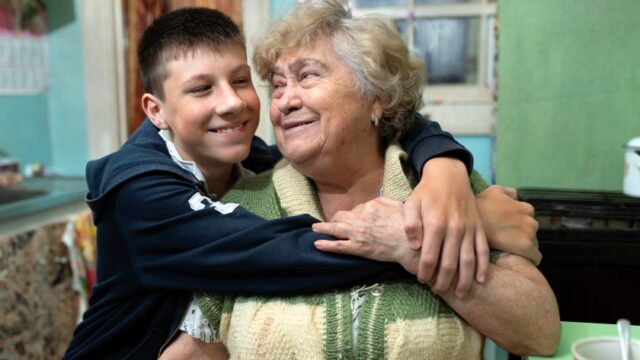Fact Sheet
School Breakfast and Lunch Programs for Grandfamilies and Kinship Families
Download This Resource

Millions of children across the country are raised by grandparents, other extended family, or close family friends when their parents are unable to raise them. These families, interchangeably known as grandfamilies and kinship families, provide a safe, stable, and loving environment for the children in their care. With the sudden increase in household and caregiving expenses, some grandfamilies and kinship families may face struggles with getting the food they need. The School Nutrition Programs – the School Breakfast Program (SBP) and the National School Lunch Program (NSLP) – provide the nutritious breakfasts and lunches children need during the school day, which can help lower household food costs for caregivers.
What Are School Meals?
All children who attend a school that participates in the School Nutrition Programs can eat school breakfast and lunch. In the 2021–2022 school year, approximately 30 million children participated in school lunch, and 15 million children participated in school breakfast, each day. As of July 2023, seven states have passed permanent Healthy School Meals for All policies offering all children access to school meals at no charge: California, Colorado, Maine, Michigan, Minnesota, New Mexico, and Vermont. Nevada has a similar policy in place for the 2023–2024 school year. Schools in the remaining 42 states, and the District of Columbia, must qualify children for free or reduced-price school meals based on household income or participation in eligible assistance programs. Children who are determined eligible for reduced-price meals can be charged a maximum of 30 cents for breakfast and 40 cents for lunch. Children who are not certified for free or reduced-price school meals are charged for their meals. The cost of school breakfast and lunch for a child who does not qualify for free or reduced-price school meals may vary from school to school.
Caregivers do not have to have legal custody or guardianship, or be related to the child they are raising, to obtain free or reduced-price meals for their student.
What Are the Benefits of School Meals?
School meals provide the nutritional foundation children need to learn, grow, and thrive. Children who participate in school meals have reduced rates of hunger, improved health outcomes, and better academic success. Additionally, utilizing school meals programs helps stretch a family’s food budget.
School meals must meet specific nutrition standards based on the Dietary Guidelines for Americans. These requirements ensure that children receive healthy meals of low-fat dairy, lean proteins, whole grains, and colorful fruits and vegetables. As a result, students who eat school meals have a better diet, consuming a greater variety of healthful food, than students who do not participate.
Free lunches … was tremendous both financially and to make sure the children had a nutritious meal
Grandparent caregiver in Louisiana
How Do I Know if My Student Is Eligible for Free or Reduced-Price School Meals?
Eligibility for free or reduced-price school meals usually depends on the child’s household income. Every year, the U.S. Department of Agriculture (USDA) releases Income Eligibility Guidelines for free and reduced-price school meals. There are a few ways that children can qualify for free or reduced-price school meals.
Automatic Eligibility
To make it easier for eligible children to qualify for free school meals, schools can automatically link certain children to free school meals, and the caregiver does not have to fill out a school meals application for the child. These children are considered “categorically eligible.”
Automatic eligibility may cover children whose household participates in any of the following programs.
- Supplemental Nutrition Assistance Program (SNAP)
- Temporary Assistance for Needy Families (TANF)
- Food Distribution Program on Indian Reservations (FDPIR)
- Medicaid (In most states, children can be certified through Medicaid if they belong to a family whose income, as defined by Medicaid, qualifies them for free or reduced-price meals. Thirty-nine states were approved to participate in the Medicaid Demonstration Project in the 2022–2023 school year. In most of these states, Medicaid is used to certify children for free or reduced-price school meals.)
Automatic eligibility can also cover children who are identified as:
- homeless or “unaccompanied youth,”
- runaway,
- migrant, or
- in foster care.
Children raised by kin with no legal relationship and without child welfare involvement may be considered “unaccompanied” and can qualify for services under the federal McKinney Vento Act.
School Meals Applications
Schools collect school meals applications each school year, and families can fill out an application at any point during the school year. Caregivers do not have to have legal custody or guardianship, or be related to the child they are raising, to obtain free or reduced-price meals for their student. Every child attending a school that participates in the School Nutrition Programs can apply for free or reduced-price school meals.
To qualify for free school meals, a child’s household annual income must be less than 130 percent of the federal poverty line or $32,318 or less for a household of three (from June 2023 to June 2024). To qualify for reduced-price school meals, a child’s household income must be between 130 and185 percent of the federal poverty line or between $32,318 and $45,991 for a family of three (from June 2023 to June 2024).
Please note that the examples used in this resource are based on the 2023–2024 Income Eligibility guidelines established for the 48 contiguous states, the District of Columbia, Guam, and the Territories. Income eligibility limits for free and reduced-price meals are higher in Alaska and Hawaii because the poverty guidelines are higher in those states.
Income Guidelines for the Child Nutrition Programs
Effective July 1, 2023 – June 30, 2024
| Household Size | Federal Poverty Guidelines for Annual Income | Free Meals Maximum Household Income (130% of Poverty) | Reduced-Price Meals Maximum Household Income (185% of Poverty) |
|---|---|---|---|
| 1 | $14,580 | $18,954 annually $1,580 monthly $365 weekly | $26,973 annually $2,248 monthly $519 weekly |
| 2 | $19,720 | $25,636 annually $2,137 monthly $493 weekly | $36,482 annually $3,041 monthly $702 weekly |
| 3 | $24,860 | $32,318 annually $2,694 monthly $622 weekly | $45,991 annually $3,833 monthly $885 weekly |
| 4 | $30,000 | $39,000 annually $3,250 monthly $750 weekly | $55,500 annually $4,625 monthly $1,068 weekly |
| 5 | $35,140 | $45,682 annually $3,807 monthly $879 weekly | $65,009 annually $5,418 monthly $1,251 weekly |
| 6 | $40,280 | $52,364 annually $4,364 monthly $1,007 weekly | $74,518 annually $6,210 monthly $1,434 weekly |
| 7 | $45,420 | $59,046 annually $4,921 monthly $1,136 weekly | $84,027 annually $7,003 monthly $1,616 weekly |
| 8 | $50,560 | $65,728 annually $5,478 monthly $1,264 weekly | $93,536 annually $7,795 monthly $1,799 weekly |
| Add for each additional member | $5,140 | $6,682 annually $557 monthly $129 weekly | $9,509 annually $793 monthly $183 weekly |
How Do I Apply for Free or Reduced-Price School Meals?
Most school districts begin accepting school meals applications immediately prior to the start of the school year; however, there is no deadline to apply – you can apply for school meals at any time throughout the school year. Eligibility lasts for one school year, and you must reapply every year to continue receiving meals. In most districts, the application may be completed online or via a paper form. If you are raising multiple children enrolled in the same school district, you only need to fill out one application, indicating all the children in your household on the same form. Applications are often available in multiple languages, or the school may offer translation services. If you have questions about your school district’s specific policies, go to the Food and Nutrition Services webpage on your school district’s website, or call your school district and request to speak with Food and Nutrition Services.
What Information Is Required to Complete a School Meals Application?
The school meals application requires the following information:
- the names and grades of each child;
- the names of all household members;
- the amount and source of income for each household member;
- the signature of an adult household member; and
- the last four digits of the Social Security number of the adult household member who signs the application. (If the adult does not have a Social Security number, they must write “none” in that space or check the box, “I do not have a Social Security number,” if provided. Children are still eligible for free or reduced-price school meals even if no one in the household has a Social Security number, but the Social Security section cannot be left blank.)
Requests on the application for any other information are strictly optional.
- If your family receives SNAP, TANF, FDPIR, or Medicaid (in most states), or if the child is in foster care or is considered homeless (“unaccompanied”), runaway, or migrant, the child(ren) should automatically qualify for free school meals without an application. However, some eligible children may be missed, requiring the household to submit a school meals application. In these cases, you do not need to complete the entire application. Instead, you will only need to provide:
- the child’s name
- the SNAP, FDPIR, TANF, and/or Medicaid case number for someone in the household, or check a box stating that the child is homeless, runaway, migrant, or in foster care; and
- the signature of an adult household member.
What if My Student Is Denied Free or Reduced-Price School Meals?
If your student’s school meals application was denied, call your school district’s Food and Nutrition Services Department to find out the reason. Oftentimes, applications are denied due to missing or inaccurate information. If so, you can resubmit an application with the corrected information. Remember, eligibility for free or reduced-price school meals is based on the household size and income.
What if My Student Changes Schools or the Family Circumstances Change?
Eligibility for free or reduced-price school meals is determined at the school district level; therefore, changing schools within a single district should not affect a student’s eligibility. Enrolling in a different school district may require you to submit a new school meals application. Contact the district’s Food and Nutrition Services department for more information.
Once determined eligible, a child may receive free or reduced-price meals for the remainder of that school year even if the household’s financial circumstances change. Caregivers may reapply at any time during the school year and are encouraged to do so if the household size increases, household income decreases, or a member of the household qualifies for another assistance program.
What Other Benefits Can My Household Receive by Participating in Free or Reduced-Price School Meals?
In addition to receiving free or reduced-price school meals, your family may be eligible to receive other benefits, including:
- SAT fee waivers;
- College application fee waivers;
- ACT fee waivers and resources;
- the Federal Communications Commission’s Affordable Connectivity Program, which provides discounted internet service; and
- other benefits, which vary by location and may include waived school uniform and/or textbook fees. Contact your school to see what other benefits may apply.
What if the School Offers All Students School Meals at No Charge?
Some schools offer all students school meals at no charge through the Community Eligibility Provision, through other Provisions to the National School Lunch Act, or through states’ Healthy School Meals for All policies. The school district may still request that you submit information about your household income or participation in assistance programs to see if your school is eligible for other benefits, such as federal Title I or state education funding.
Where Can I Receive Food Assistance When School is Closed for the Summer?
The Summer Nutrition Programs can provide meals and benefits to eligible children over the summer months. Contact your local school district or your state administering agency to learn more.
Where Can I Learn More Information About the School Meals Program?
For more information about the school meals program at your school, contact your district’s Food and Nutrition Services Department, parent liaison, or guidance counselor.
For more information about school meals in general, visit the Food Research & Action Center’s School Breakfast Program and National School Lunch Program webpages.
For more information on food assistance for grandfamilies and kinship families, visit the Food Research & Action Center’s Hunger Among Grandfamilies and Kinship Families webpage.


